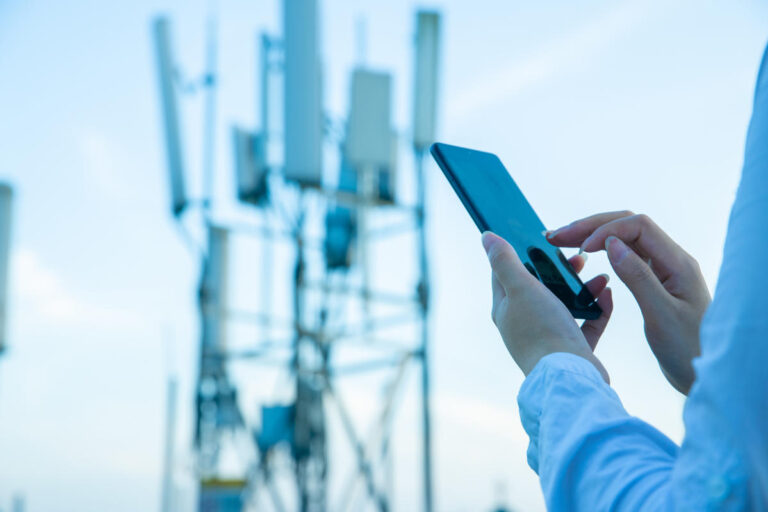Recent TikTok videos and social media posts have highlighted the issues in the UK, where users are finding it difficult to connect to 5G phone service, and many believe 5G is getting worse rather than better.
Twitter users have been complaining about spotty 5G service, inconvenient disconnections and slow 5G speeds, with one person calling for TV presenter Stacey Dooley to investigate.
A recent video by TikTok user Professor Make It Make Sense suggests that former Prime Minister Liz Truss’ decision to order the removal of Huawei equipment from Britain’s phone network over security concerns may be to blame, while other experts say the towers are being built too late and in the wrong places.
Is 5G in the UK really worse than elsewhere?
The study found that the UK’s 5G network is slower and less reliable than other European countries.
A study comparing major European cities in February this year by mobile network analytics firm MedUX found that London had the worst 5G speeds for both upload and download, while Lisbon was 75% faster.
London also had the second-worst performance in reliability and accessibility, which is measured by the time it takes to deliver content to devices.
MedUX used a car that drove around each city to test 5G speeds, finding that Lisbon had the fastest download and upload speeds, while Berlin and Paris had the best video streaming speeds.
MedUX CMO Rafael Gonzalez told Yahoo News that countries that are slow to invest in 5G need to accelerate.
“The differences in 5G performance and experience across Europe’s major cities are a wake-up call. Setting an ambitious national digital infrastructure strategy roadmap and accelerating the pace of investment and deployment is essential to catch up with world-class tech leaders,” Gonzalez said.
Why did the UK ban Huawei equipment?
In 2020, the United States warned its allies not to allow Huawei to participate in their 5G networks, arguing that the Chinese company’s close ties to the Beijing government were a security risk.
Critics have argued that the Chinese government could pressure Huawei to install “backdoors” in its equipment for espionage or simply to shut down networks.
In 2020, the US Department of Defense added Huawei to a list of companies controlled by the Chinese military, and then-Prime Minister Boris Johnson announced that Huawei equipment would be removed from Britain’s 5G network by 2027.
In 2022, Chancellor Liz Truss served legal notices on UK telecommunications networks to formally implement the measures.
Is the Huawei ban to blame for the UK’s poor 5G?
Relatively few companies have Huawei’s expertise in providing 5G network equipment, so the removal of Huawei equipment may have delayed the rollout of 5G.
“While the Huawei ban may have caused a setback for the industry, the lagging quality of experience in the UK capital can be attributed to a range of factors, including spectrum policy, rollout strategy, investment efforts and the level of support for 5G rollout from the government and other public stakeholders,” MedUX’s Gonzalez said.
Currently, Britain’s networks are rolling out 5G hardware on top of existing 4G equipment, and they use mid-band frequencies that aren’t as fast as those in other countries, said Liz Parry, CEO of communications services support company Lifecycle Software.
Parry said the process of replacing Huawei equipment with that of other companies such as Ericsson or Nokia would be long and costly.
“5G speeds are not yet meeting expectations because the networks needed for 5G are not yet fully operational,” said Andy Aitken, co-founder and CEO of British telecoms network Honest. “The big telecoms companies will need to expand their infrastructure, which will cost billions of dollars.”
“Plus, regulations slow things down – for example, you can easily put up 50-metre-tall antennas in China. You can’t do that in the UK because of planning regulations. This makes a big difference to the efficiency of 5G rollout. On top of that, the UK’s ‘big four’ networks can choose to erect antennas where they expect the most usage, such as congested city centres, but have little interest or incentive to put antennas in less populated areas.”
How to check for 5G signals in my area
Before signing up to a particular network, you can use Ofcom’s free Mobile Checker to assess both indoor and outdoor signal levels in your area.
The free website allows you to enter your postcode and assesses the coverage of each of the “Big Four” networks – EE, Three, 02 and Vodafone – at your particular address, warning you if service is “limited”.
How long will it take for 5G to roll out across the UK?
The rollout of 5G services in the UK began in 2019, with 5G services being rolled out by the four major private mobile network operators.
In September 2023, Ofcom estimated that between 85% and 93% of UK premises will have outdoor 5G coverage from at least one operator.
Currently, much of 5G is built on top of existing 4G equipment, and “standalone” 5G, with dedicated 5G equipment everywhere, is in its “early stages”, the government says.
The government’s official goal is to achieve standalone 5G coverage in “all populated areas” by 2030, including in rural areas of the country.


